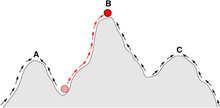Shifting balance theory
The shifting balance theory is a theory of evolution proposed in 1932 by Sewall Wright, suggesting that adaptive evolution may proceed most quickly when a population divides into subpopulations with restricted gene flow.
The name of the theory is borrowed from Wright's metaphor of fitness landscapes (evolutionary landscapes), attempting to explain how a population may move across an adaptive valley to a higher adaptive peak.
According to the theory, this movement occurs in three steps: Although shifting balance theory has been influential in evolutionary biology, inspiring the theories of quantum evolution and punctuated equilibrium,[1] little empirical evidence exists to support the shifting balance process as an important factor in evolution.
[2]
